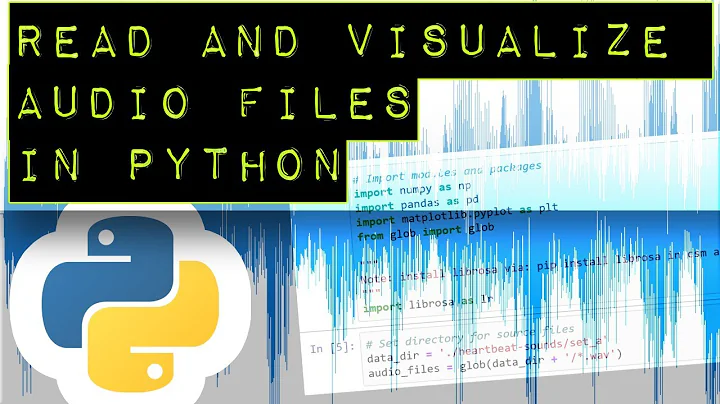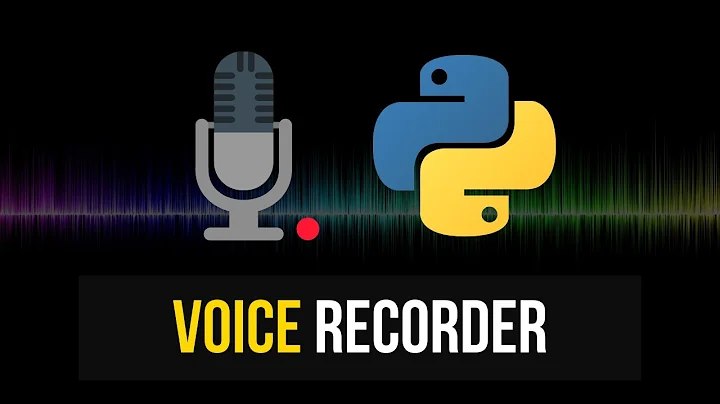Detect & Record Audio in Python
Solution 1
As a follow up to Nick Fortescue's answer, here's a more complete example of how to record from the microphone and process the resulting data:
from sys import byteorder
from array import array
from struct import pack
import pyaudio
import wave
THRESHOLD = 500
CHUNK_SIZE = 1024
FORMAT = pyaudio.paInt16
RATE = 44100
def is_silent(snd_data):
"Returns 'True' if below the 'silent' threshold"
return max(snd_data) < THRESHOLD
def normalize(snd_data):
"Average the volume out"
MAXIMUM = 16384
times = float(MAXIMUM)/max(abs(i) for i in snd_data)
r = array('h')
for i in snd_data:
r.append(int(i*times))
return r
def trim(snd_data):
"Trim the blank spots at the start and end"
def _trim(snd_data):
snd_started = False
r = array('h')
for i in snd_data:
if not snd_started and abs(i)>THRESHOLD:
snd_started = True
r.append(i)
elif snd_started:
r.append(i)
return r
# Trim to the left
snd_data = _trim(snd_data)
# Trim to the right
snd_data.reverse()
snd_data = _trim(snd_data)
snd_data.reverse()
return snd_data
def add_silence(snd_data, seconds):
"Add silence to the start and end of 'snd_data' of length 'seconds' (float)"
silence = [0] * int(seconds * RATE)
r = array('h', silence)
r.extend(snd_data)
r.extend(silence)
return r
def record():
"""
Record a word or words from the microphone and
return the data as an array of signed shorts.
Normalizes the audio, trims silence from the
start and end, and pads with 0.5 seconds of
blank sound to make sure VLC et al can play
it without getting chopped off.
"""
p = pyaudio.PyAudio()
stream = p.open(format=FORMAT, channels=1, rate=RATE,
input=True, output=True,
frames_per_buffer=CHUNK_SIZE)
num_silent = 0
snd_started = False
r = array('h')
while 1:
# little endian, signed short
snd_data = array('h', stream.read(CHUNK_SIZE))
if byteorder == 'big':
snd_data.byteswap()
r.extend(snd_data)
silent = is_silent(snd_data)
if silent and snd_started:
num_silent += 1
elif not silent and not snd_started:
snd_started = True
if snd_started and num_silent > 30:
break
sample_width = p.get_sample_size(FORMAT)
stream.stop_stream()
stream.close()
p.terminate()
r = normalize(r)
r = trim(r)
r = add_silence(r, 0.5)
return sample_width, r
def record_to_file(path):
"Records from the microphone and outputs the resulting data to 'path'"
sample_width, data = record()
data = pack('<' + ('h'*len(data)), *data)
wf = wave.open(path, 'wb')
wf.setnchannels(1)
wf.setsampwidth(sample_width)
wf.setframerate(RATE)
wf.writeframes(data)
wf.close()
if __name__ == '__main__':
print("please speak a word into the microphone")
record_to_file('demo.wav')
print("done - result written to demo.wav")
Solution 2
I believe the WAVE module does not support recording, just processing existing files. You might want to look at PyAudio for actually recording. WAV is about the world's simplest file format. In paInt16 you just get a signed integer representing a level, and closer to 0 is quieter. I can't remember if WAV files are high byte first or low byte, but something like this ought to work (sorry, I'm not really a python programmer:
from array import array
# you'll probably want to experiment on threshold
# depends how noisy the signal
threshold = 10
max_value = 0
as_ints = array('h', data)
max_value = max(as_ints)
if max_value > threshold:
# not silence
PyAudio code for recording kept for reference:
import pyaudio
import sys
chunk = 1024
FORMAT = pyaudio.paInt16
CHANNELS = 1
RATE = 44100
RECORD_SECONDS = 5
p = pyaudio.PyAudio()
stream = p.open(format=FORMAT,
channels=CHANNELS,
rate=RATE,
input=True,
output=True,
frames_per_buffer=chunk)
print "* recording"
for i in range(0, 44100 / chunk * RECORD_SECONDS):
data = stream.read(chunk)
# check for silence here by comparing the level with 0 (or some threshold) for
# the contents of data.
# then write data or not to a file
print "* done"
stream.stop_stream()
stream.close()
p.terminate()
Solution 3
Thanks to cryo for improved version that I based my tested code below:
#Instead of adding silence at start and end of recording (values=0) I add the original audio . This makes audio sound more natural as volume is >0. See trim()
#I also fixed issue with the previous code - accumulated silence counter needs to be cleared once recording is resumed.
from array import array
from struct import pack
from sys import byteorder
import copy
import pyaudio
import wave
THRESHOLD = 500 # audio levels not normalised.
CHUNK_SIZE = 1024
SILENT_CHUNKS = 3 * 44100 / 1024 # about 3sec
FORMAT = pyaudio.paInt16
FRAME_MAX_VALUE = 2 ** 15 - 1
NORMALIZE_MINUS_ONE_dB = 10 ** (-1.0 / 20)
RATE = 44100
CHANNELS = 1
TRIM_APPEND = RATE / 4
def is_silent(data_chunk):
"""Returns 'True' if below the 'silent' threshold"""
return max(data_chunk) < THRESHOLD
def normalize(data_all):
"""Amplify the volume out to max -1dB"""
# MAXIMUM = 16384
normalize_factor = (float(NORMALIZE_MINUS_ONE_dB * FRAME_MAX_VALUE)
/ max(abs(i) for i in data_all))
r = array('h')
for i in data_all:
r.append(int(i * normalize_factor))
return r
def trim(data_all):
_from = 0
_to = len(data_all) - 1
for i, b in enumerate(data_all):
if abs(b) > THRESHOLD:
_from = max(0, i - TRIM_APPEND)
break
for i, b in enumerate(reversed(data_all)):
if abs(b) > THRESHOLD:
_to = min(len(data_all) - 1, len(data_all) - 1 - i + TRIM_APPEND)
break
return copy.deepcopy(data_all[_from:(_to + 1)])
def record():
"""Record a word or words from the microphone and
return the data as an array of signed shorts."""
p = pyaudio.PyAudio()
stream = p.open(format=FORMAT, channels=CHANNELS, rate=RATE, input=True, output=True, frames_per_buffer=CHUNK_SIZE)
silent_chunks = 0
audio_started = False
data_all = array('h')
while True:
# little endian, signed short
data_chunk = array('h', stream.read(CHUNK_SIZE))
if byteorder == 'big':
data_chunk.byteswap()
data_all.extend(data_chunk)
silent = is_silent(data_chunk)
if audio_started:
if silent:
silent_chunks += 1
if silent_chunks > SILENT_CHUNKS:
break
else:
silent_chunks = 0
elif not silent:
audio_started = True
sample_width = p.get_sample_size(FORMAT)
stream.stop_stream()
stream.close()
p.terminate()
data_all = trim(data_all) # we trim before normalize as threshhold applies to un-normalized wave (as well as is_silent() function)
data_all = normalize(data_all)
return sample_width, data_all
def record_to_file(path):
"Records from the microphone and outputs the resulting data to 'path'"
sample_width, data = record()
data = pack('<' + ('h' * len(data)), *data)
wave_file = wave.open(path, 'wb')
wave_file.setnchannels(CHANNELS)
wave_file.setsampwidth(sample_width)
wave_file.setframerate(RATE)
wave_file.writeframes(data)
wave_file.close()
if __name__ == '__main__':
print("Wait in silence to begin recording; wait in silence to terminate")
record_to_file('demo.wav')
print("done - result written to demo.wav")
Solution 4
import pyaudio
import wave
from array import array
FORMAT=pyaudio.paInt16
CHANNELS=2
RATE=44100
CHUNK=1024
RECORD_SECONDS=15
FILE_NAME="RECORDING.wav"
audio=pyaudio.PyAudio() #instantiate the pyaudio
#recording prerequisites
stream=audio.open(format=FORMAT,channels=CHANNELS,
rate=RATE,
input=True,
frames_per_buffer=CHUNK)
#starting recording
frames=[]
for i in range(0,int(RATE/CHUNK*RECORD_SECONDS)):
data=stream.read(CHUNK)
data_chunk=array('h',data)
vol=max(data_chunk)
if(vol>=500):
print("something said")
frames.append(data)
else:
print("nothing")
print("\n")
#end of recording
stream.stop_stream()
stream.close()
audio.terminate()
#writing to file
wavfile=wave.open(FILE_NAME,'wb')
wavfile.setnchannels(CHANNELS)
wavfile.setsampwidth(audio.get_sample_size(FORMAT))
wavfile.setframerate(RATE)
wavfile.writeframes(b''.join(frames))#append frames recorded to file
wavfile.close()
I think this will help.It is a simple script which will check if there is a silence or not.If silence is detected it will not record otherwise it will record.
Solution 5
The pyaudio website has many examples that are pretty short and clear: http://people.csail.mit.edu/hubert/pyaudio/
Update 14th of December 2019 - Main example from the above linked website from 2017:
"""PyAudio Example: Play a WAVE file."""
import pyaudio
import wave
import sys
CHUNK = 1024
if len(sys.argv) < 2:
print("Plays a wave file.\n\nUsage: %s filename.wav" % sys.argv[0])
sys.exit(-1)
wf = wave.open(sys.argv[1], 'rb')
p = pyaudio.PyAudio()
stream = p.open(format=p.get_format_from_width(wf.getsampwidth()),
channels=wf.getnchannels(),
rate=wf.getframerate(),
output=True)
data = wf.readframes(CHUNK)
while data != '':
stream.write(data)
data = wf.readframes(CHUNK)
stream.stop_stream()
stream.close()
p.terminate()
Related videos on Youtube
SilentGhost
We are all here on earth to help others; what on earth the others are here for, I've no idea -- W.H. Auden Give man a fish and you got him fed for a night; teach him to fish and it's not your fault he died of mercury poisoning. --unknown
Updated on February 03, 2020Comments
-
SilentGhost over 4 years
I need to capture audio clips as WAV files that I can then pass to another bit of python for processing. The problem is that I need to determine when there is audio present and then record it, stop when it goes silent and then pass that file to the processing module.
I'm thinking it should be possible with the wave module to detect when there is pure silence and discard it then as soon as something other than silence is detected start recording, then when the line goes silent again stop the recording.
Just can't quite get my head around it, can anyone get me started with a basic example.
-
 Admin about 15 yearsThanks Nick, Yes should have said I'm also using portaudio for the capture, the bit I'm stuck on is the checking for silence, how to I get the level in the chunk of data?
Admin about 15 yearsThanks Nick, Yes should have said I'm also using portaudio for the capture, the bit I'm stuck on is the checking for silence, how to I get the level in the chunk of data? -
Nick Fortescue about 15 yearsI've added some really simple untested code above, but it ought to do the job you want
-
Nick Fortescue about 15 yearsMy previous version had a bug, wasn't dealing with the sign properly. I've used the library function array() to parse properly now
-
Jacek Konieczny almost 13 yearsWAV file format is a container, it may contain audio encoded via various codecs (like GSM or MP3), some far from being 'world's simplest'.
-
Binus over 9 yearsI believe the option "output=True" while opening the stream is not necessary for recording and furthermore it seem to cause "IOError: [Errno Input overflowed] -9981" on my device. Otherwise thanks for the code example, it was super helpful.
-
Ben Elgar over 9 yearsTo make this work in Python 3 just replace xrange with range.
-
Swan87 about 8 yearsGreat example! Really useful when I tried to wrap my head around how to record voice using Python. One quick question I had is whether there is a way to define the time period of the recording. Now it records a word? Can I play with it and have a record period of e.g. 10 seconds? Thanks!
-
 ArekBulski over 7 yearsDetection and normalization are not correct, because they compute on bytes and not shorts. That buffer would have to be converted into a numpy array before processing.
ArekBulski over 7 yearsDetection and normalization are not correct, because they compute on bytes and not shorts. That buffer would have to be converted into a numpy array before processing. -
Tomasz Gandor over 4 yearsNeither
xrangenorrangewas really necessary inadd_silence(so it's gone now). I think Arek may be onto something here - the transition from silence to the 'word' sounds too jerky. I think there are other answers which address it also. -
 lukassliacky about 4 yearsthanks, works great. In my case i have to edit
lukassliacky about 4 yearsthanks, works great. In my case i have to editreturn copy.deepcopy(data_all[_from:(_to + 1)])tocopy.deepcopy(data_all[int(_from):(int(_to) + 1)]) -
E. T. over 3 yearsFor what it's worth, it was pointed out here that this snippet might have a problem with the silence trim part right now: stackoverflow.com/questions/64491394/… (remarked by someone new who doesn't have the points to comment here yet) I didn't test it myself, so I'm just relaying this information.
-
 Lorenzo Sciuto over 3 yearsthe fix suggested by lukassliacky is required to let this very good solution work someone should accept the edit.
Lorenzo Sciuto over 3 yearsthe fix suggested by lukassliacky is required to let this very good solution work someone should accept the edit. -
Marki555 almost 3 yearsThe question was not about playing audio, but recording + detecting and removing silence.







